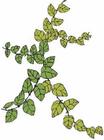
Heather Little-White, Contributor
While there is talk about the virtues of Jamaican yams and their probable contribution to the success of our Olympians in Beijing, traditional yam lovers shouldn't go wild about all varieties.
The wild yam, for example, is a herb, not a tuber that you would expect to cook to accompany a tasty dish of oxtail and beans, or ackee and salt fish for your favourite culinary treat. It is only distantly related to edible yams.
According to Wikipedia, the wild yam, also known as Dioscorea villosa, is a species of a delicate, twining tuberous vine that is native to and found growing wild in North America. Also found wild in abundance in the eastern half of North America, wild yam is a perennial creeping plant which will thrive in poor soils and can take exposure to full sun. Wild yam is also known as China root, Mexican yam, colic root, devil's bones, rheumatism root and yuma.
History
Historically, in East Indian traditional medicine, wild yam is used for sexual and hormonal problems. Chinese herbalists have long used the herb for rheumatism, asthma and digestive and urinary complaints. Wild yams have also been used in American folk medicine to treat coughs and to induce sweating and vomiting. Some sources suggest that Native Americans and early settlers used it for its antispasmodic effects, which is how it got the name, 'colic root'.
Hormonal herb
Wild yam has several uses and is noted for its steroid-like saponins which can be chemically converted to progesterone contraceptives and cortisone. It is known as the hormonal herb and several women have claimed success in using it for birth control. A midwife in Utah, Willa Shaffer, with the help of volunteers, tested several dosages and made adjustments which, when given to women in the sample, prevented them from conceiving.
Shaffer believes that the herb is safe to take daily without side effects (www.sis terzeus.com).
However, the question of reliability is critical when it comes to using wild yam to prevent pregnancy. The area of herbal contraception needs scientific research to explore the potential and safety of wild yam. The United States Food and Drug Administraion has not yet tested wild yam for use as a contraceptive.
Female irregularities
It is believed that wild yam will be helpful to the renal and endocrinological system. It tones and nourishes the liver, helping to balance hormone production. Wild yam is known to treat a number of female irregularities, such as:
Irregular menstruation
Menstrual cramps Infertility Menopause EndometriosisHerbalists claim that when used with chaste berry and dandelion, it is an effective treatment for morning sickness.Suffering from hot flashes or pre-menstrual syndrome? The wild yam cream is the perfect natural find for some sufferers. The cream is made from a form of progesterone made from a wild Mexican yam. By rubbing the cream on the soft areas of the body on the ninth day of the menstrual cycle, women claim that the body eventually produces all the progesterone it needs. Females appreciate the side effects that come from using the wild yam cream. These effects are increased sexual libido and a wonderful sense of euphoria.Wild Yam cream
Can men use wild yam cream? Beth Ellyn Rosenthal of the Natural Health and Longevity Centre in the US, writing on the virtues of wild yam cream, quoted: "I sold a jar of wild yam cream to a man in my office who wanted the jar for his wife. Three days later, the wife called on the phone. He was out of the office, so I asked her how she enjoyed the cream. She said, 'What cream?'
"When he returned, I asked him what he was doing with the cream. After he turned red, he explained that as he got older, he had trouble reaching orgasm. He wanted the cream to help him out here. He felt extra progesterone would give him the boost he needed. It must have worked, because he bought a second jar for his wife!"
The anti-inflammatory properties of wild yam may provide relief for persons suffering from arthritis, tendonitis and muscle and joint pain. Chinese recognise the anti-inflammatory, antispasmodic, especially when there is tension with 'restrained or constrained chi'. This is particularly useful in tense conditions of the body, as in cramping of the stomach or intestines, irritable bowel, colitis and diverticulitis. Wild yam, in many instances, may ease gas pain, vomiting and hiccups. It can relieve spasms and pain in the urinary tract and may be helpful in strengthening the bladder sphincter in urinary incontinence.
Tonic or tea?
The diversity of wild yams depends on how it is taken, which determines the effect on the body. The herb, taken in tea form, for example, has a different effect on the body than when used as a powder or tincture. Men claim sexual potency when they use it as a sexual tonic and that it aids their fertility. There is no conclusive evidence for the boost in male fertility, similar to the lack of scientific proof that women who add wild yam to herbal formulas experienced increased fertility.
Wild yam used in cultural and traditional settings will differ from accepted practices in current Western medicine. When considering the use of herbal supplements, consultation with a practitioner trained in the uses of herbal/health supplements should be considered and the coordination of treatment among all health-care providers involved may be advantageous. Health-care providers will be able to discuss interactions between wild yam and prescription or over-the-counter drugs.
Heather Little-White, PhD, is a nutrition and lifestyle consultant in the Corporate Area. Send comments to:columns@gleanerjm.com.

